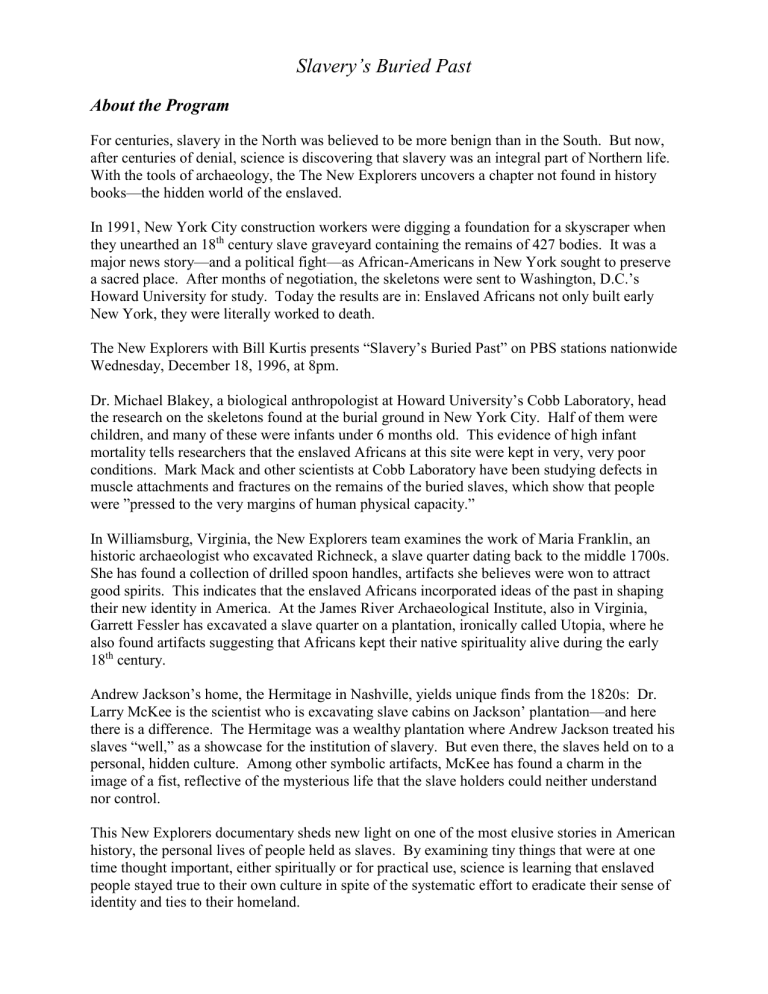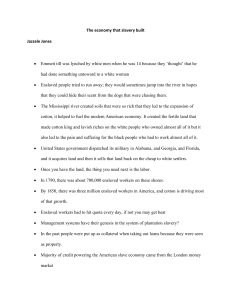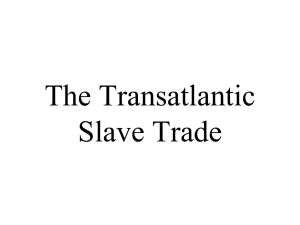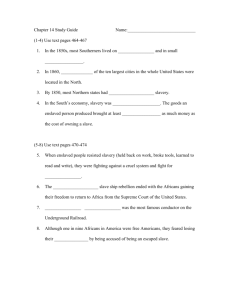Slavery`s Buried Past

Slavery’s Buried Past
About the Program
For centuries, slavery in the North was believed to be more benign than in the South. But now, after centuries of denial, science is discovering that slavery was an integral part of Northern life.
With the tools of archaeology, the The New Explorers uncovers a chapter not found in history books—the hidden world of the enslaved.
In 1991, New York City construction workers were digging a foundation for a skyscraper when they unearthed an 18 th
century slave graveyard containing the remains of 427 bodies. It was a major news story—and a political fight—as African-Americans in New York sought to preserve a sacred place. After months of negotiation, the skeletons were sent to Washington, D.C.’s
Howard University for study. Today the results are in: Enslaved Africans not only built early
New York, they were literally worked to death.
The New Explorers with Bill Kurtis presents “Slavery’s Buried Past” on PBS stations nationwide
Wednesday, December 18, 1996, at 8pm.
Dr. Michael Blakey, a biological anthropologist at Howard University’s Cobb Laboratory, head the research on the skeletons found at the burial ground in New York City. Half of them were children, and many of these were infants under 6 months old. This evidence of high infant mortality tells researchers that the enslaved Africans at this site were kept in very, very poor conditions. Mark Mack and other scientists at Cobb Laboratory have been studying defects in muscle attachments and fractures on the remains of the buried slaves, which show that people were ”pressed to the very margins of human physical capacity.”
In Williamsburg, Virginia, the New Explorers team examines the work of Maria Franklin, an historic archaeologist who excavated Richneck, a slave quarter dating back to the middle 1700s.
She has found a collection of drilled spoon handles, artifacts she believes were won to attract good spirits. This indicates that the enslaved Africans incorporated ideas of the past in shaping their new identity in America. At the James River Archaeological Institute, also in Virginia,
Garrett Fessler has excavated a slave quarter on a plantation, ironically called Utopia, where he also found artifacts suggesting that Africans kept their native spirituality alive during the early
18 th
century.
Andrew Jackson’s home, the Hermitage in Nashville, yields unique finds from the 1820s: Dr.
Larry McKee is the scientist who is excavating slave cabins on Jackson’ plantation—and here there is a difference. The Hermitage was a wealthy plantation where Andrew Jackson treated his slaves “well,” as a showcase for the institution of slavery. But even there, the slaves held on to a personal, hidden culture. Among other symbolic artifacts, McKee has found a charm in the image of a fist, reflective of the mysterious life that the slave holders could neither understand nor control.
This New Explorers documentary sheds new light on one of the most elusive stories in American history, the personal lives of people held as slaves. By examining tiny things that were at one time thought important, either spiritually or for practical use, science is learning that enslaved people stayed true to their own culture in spite of the systematic effort to eradicate their sense of identity and ties to their homeland.











